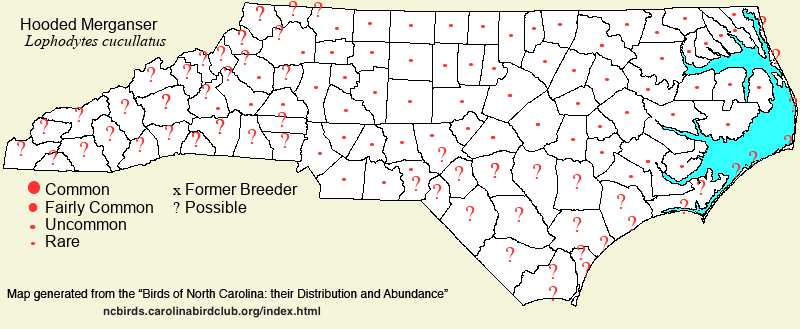 |  |
|
Hooded Merganser - Lophodytes cucullatus ANATIDAE Members: | Search Common: Search Scientific: |
|
|
|||||||
| General Comments | Another beautiful duck, the Hooded Merganser is also one of the few species of waterfowl that nests in the state, breeding (often in association with Wood Ducks) at a few wooded ponds and lakes. It is primarily known, however, as a winter resident, and thankfully, numbers have increased considerably in the state over the past several decades. Breeding and wintering habitat has increased, owing in part to increased number of beavers (and their ponds). This is one of the few divers that favors fresh water over salt/brackish waters, being most often seen on impoundments, ponds, and lakes -- favoring areas close to forests, or at least close to some type of vegetative cover. | ||||||
| Breeding Status | Breeder | ||||||
| NC BRC List | Definitive | ||||||
| State Status | W | ||||||
| U.S. Status | |||||||
| State Rank | S1B,S4N | ||||||
| Global Rank | G5 | ||||||
| Coastal Plain | Winter resident, and local breeding resident inland. Common in winter in most areas near the coast and in the Tidewater zone, being slightly less numerous near the southern coast. Occurs mostly on impoundments and lakes, but also present on tidal creeks and along the margins of bays, as long as cover is nearby. Farther inland, suitable habitat is more sporadic, but fairly common to locally common in winter. Mostly late Oct to mid-Apr. Also, a rare and local breeder, mostly around small wooded ponds where nest boxes have been erected. The majority of the nests have been far inland, near the Fall Line. Peak counts: | ||||||
| Piedmont | Winter resident, and local breeding resident. In winter, generally fairly common, being more numerous near the Fall Line; may be locally common at a few places. Mainly mid-Nov to mid-Apr. Rare and local breeder, mainly at small forested ponds, particularly those with nest boxes. Peak counts: 1,200, Lake Crabtree (Wake), 7 Jan 2018. | ||||||
| Mountains | Winter resident or visitor, and summer resident in very small numbers. Generally uncommon, and mostly at lower elevations, in winter. Late Oct to mid-Apr. Very rare breeder. Conclusive nesting in Transylvania at Cedar Mountain community, and apparent nesting in Julian Price Park in Watauga; potential breeding records elsewhere. Peak counts: | ||||||
| Finding Tips |
The species can usually be found on most of the coastal impoundments in the winter, such as at Pea Island and around the margins of Lake Mattamuskeet and adjacent impoundments. Most inland CBC's record the species, and some reservoirs (such as Beaverdam Reservoir) often have them by the dozens. *** to **** | ||||||
| Attribution | LeGrand[2023-03-02], LeGrand[2018-06-09], LeGrand[2018-02-02] | ||||||
| NC Map Map depicts all counties with a report (transient or resident) for the species. | Click on county for list of all known species. |
| NC Breeding Season Map Map depicts assumed breeding season abundance for the species. |  |